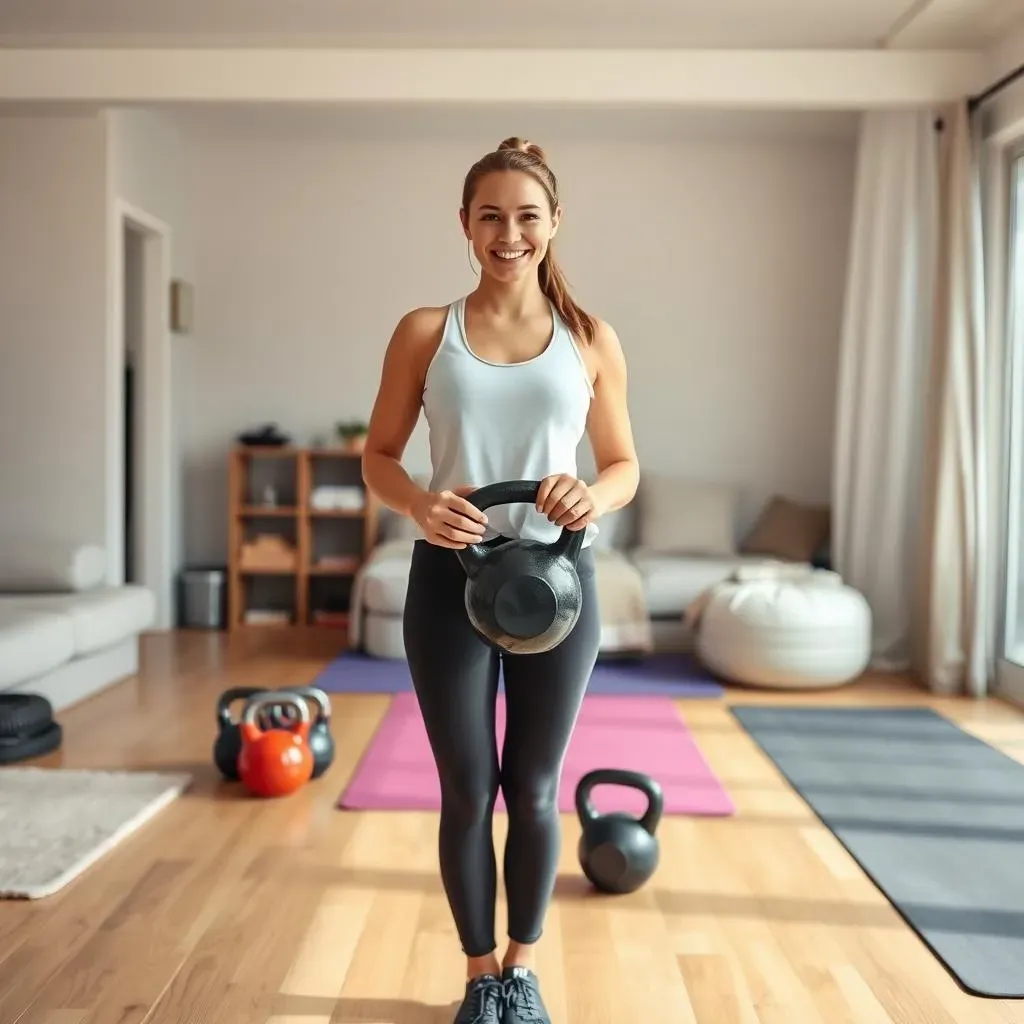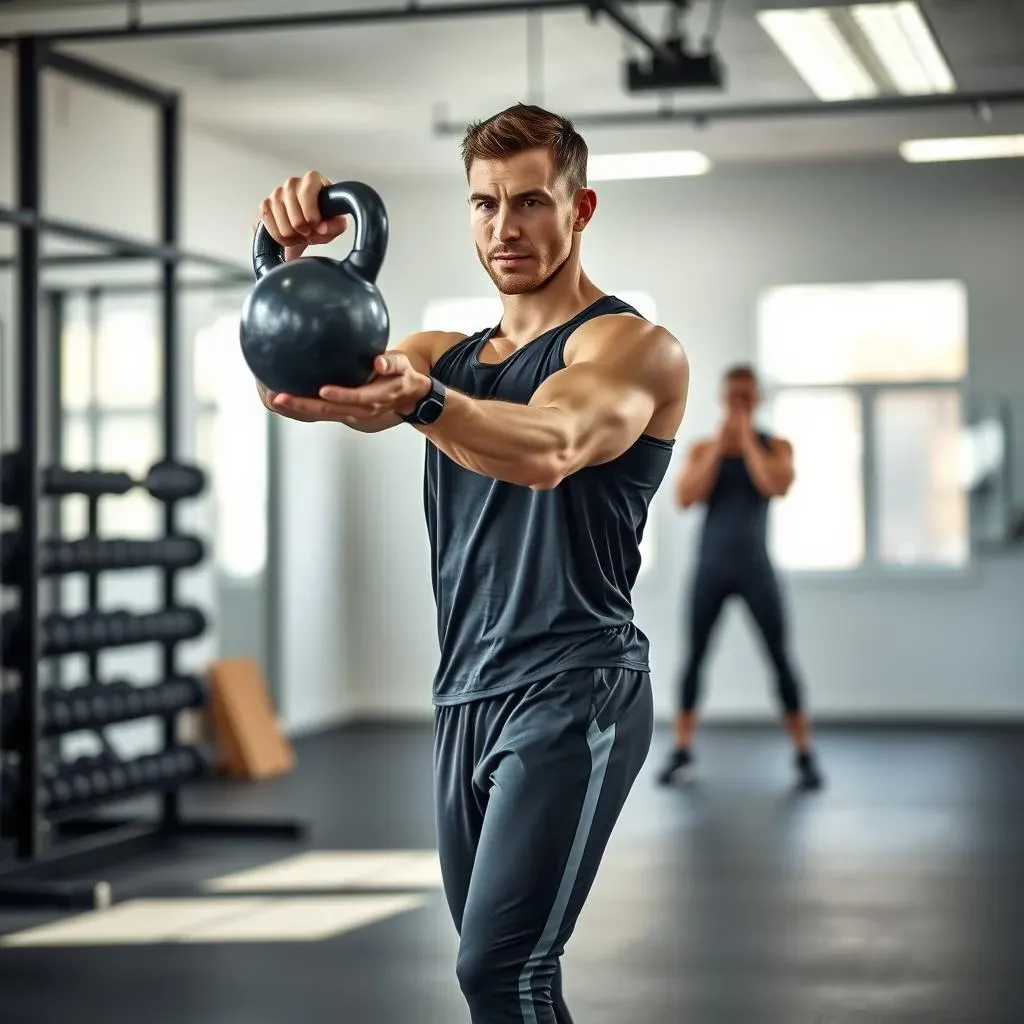Table of Contents
Ready to unleash your inner strength and sculpt the body you've always dreamed of? Then grab your kettlebell, ladies! This guide is your passport to a fantastic "beginner kettlebell workout female" experience, designed to empower you with simple yet effective exercises. We'll explore the incredible benefits of kettlebell training specifically tailored for women, helping you build strength, improve posture, and boost your overall fitness. Forget complicated routines and intimidating gyms; we'll show you how to choose the right kettlebell weight, set up your perfect workout space, and master nine essential exercises. Don't worry if you're a complete newbie – we'll break down each move step-by-step, ensuring you feel confident and comfortable throughout. This isn't just about physical transformation; it's about empowering you to take control of your fitness journey. Get ready to discover the joy and strength that kettlebell training can bring. We’ll even provide a sample 4-week plan to keep you motivated and on track. Let's get started on your path to a stronger, healthier, and more confident you!
Benefits of Kettlebell Training for Women

Benefits of Kettlebell Training for Women
Hey there! So you're diving into the world of kettlebell training for women? Fantastic choice! Let me tell you, it's not just about getting toned arms; it's a whole-body transformation. Kettlebells are seriously amazing for building functional strength – the kind that helps you with everyday life, like carrying groceries or playing with your kids. You'll notice a huge difference in your core strength, which improves your posture and stability. That means fewer aches and pains and more confidence in your movements. Plus, kettlebell workouts are super efficient. You get a killer cardio and strength training session all in one go, saving you tons of time. Think of it as a supercharged workout in a fraction of the time! Need a full-body routine? Check out this 1 kettlebell full-body workout.
Benefit | Description |
|---|---|
Increased Strength | Builds muscle throughout your entire body. |
Improved Core Strength | Strengthens your core muscles for better posture and stability. |
Enhanced Cardiovascular Fitness | Provides a great cardio workout, burning calories and improving heart health. |
But wait, there's more! Kettlebells aren't just about muscle; they also improve your bone density. This is super important as we age, helping prevent osteoporosis. And let’s not forget the mental benefits. The feeling of accomplishment after a great kettlebell workout is unbeatable. You'll feel stronger, more confident, and ready to tackle anything. For a structured plan, try our 4-week kettlebell program. It's a fantastic way to build a solid foundation and track your progress.
- Improved Bone Density
- Increased Metabolism
- Improved Balance and Coordination
- Enhanced Flexibility
One of my favorite things about kettlebells is their versatility. You can easily adjust the weight to match your fitness level, and there are tons of exercises to keep things interesting. This prevents boredom and keeps you motivated. Want more ideas? Here's a beginner kettlebell workout to get you started. Remember, consistency is key. Even short, regular workouts can make a massive difference. You'll be amazed at how quickly you see results.
Choosing the Right Kettlebell and Setting Up Your Space

Choosing the Right Kettlebell and Setting Up Your Space
Okay, so you're ready to rock those kettlebell workouts, but first, let's talk about choosing the right kettlebell and setting up your space. Picking the correct weight is crucial. Too heavy, and you risk injury and frustration. Too light, and you won't get the results you're after. Start with a lighter kettlebell (8-12kg is a good starting point for many women, but listen to your body!), focusing on perfect form before increasing the weight. Don't be afraid to experiment – try a few different weights to find what feels comfortable and challenging. For more info on exercises, check out this guide to 3 best kettlebell exercises.
- Start light and gradually increase weight.
- Prioritize proper form over heavy weight.
- Listen to your body and take breaks when needed.
Next, let’s get your workout space ready. You don't need a fancy gym; a clear space in your living room or backyard will do just fine. Make sure you have enough room to move freely without bumping into anything. A soft surface like a mat can make a big difference in comfort, especially for floor exercises. Good lighting and some upbeat music can also boost your workout experience. Consider trying a 15-minute beginner kettlebell workout to get a feel for it.
Space Requirement | Recommendation |
|---|---|
Floor Space | At least 6 feet by 6 feet of clear space. |
Surface | A yoga mat or similar soft surface is recommended. |
Lighting | Good lighting to ensure proper form. |
Finally, wear comfortable, athletic clothing that allows for a full range of motion. Avoid anything too baggy or restrictive. Many women prefer to train barefoot or in thin-soled shoes for better stability and feel. Remember, safety is key. If something feels wrong, stop and adjust your form or weight. Always prioritize proper technique over speed or intensity. For a more comprehensive beginner's guide, check out our ultimate beginner kettlebell routine. It's packed with valuable tips and exercise ideas.
Mastering the 9 Essential Kettlebell Exercises

Mastering the 9 Essential Kettlebell Exercises
Mastering the Kettlebell Swing: Your Foundation Exercise
Let's start with the king of kettlebell exercises: the swing! It's deceptively simple but incredibly effective for building full-body strength and power. The swing primarily targets your posterior chain—your glutes, hamstrings, and lower back—but it also engages your core and shoulders. Imagine it like this: you're using your legs to generate power, transferring that energy through your hips and core, and finally, propelling the kettlebell upwards. Focus on a powerful hip hinge, keeping your back straight and your core engaged. Don't just swing with your arms; it's all about that hip drive! For a more detailed breakdown, check out this guide to two-handed kettlebell exercises.
- Maintain a straight back throughout the movement.
- Engage your core to protect your spine.
- Focus on hip drive, not arm strength.
A common mistake is rounding the back, which can lead to injury. So, pay close attention to your posture. Start with lighter weight and gradually increase it as you get stronger. Remember, quality over quantity! Mastering the swing sets the stage for many other advanced kettlebell movements. For a great core workout alongside swings, try this beginner kettlebell ab workout.
Adding the Kettlebell Goblet Squat: Building Lower Body Strength
Next up is the goblet squat, a fantastic exercise for building lower body strength and stability. Hold the kettlebell close to your chest, like you're holding a goblet (hence the name!). Then, squat down as if you're sitting in a chair, keeping your back straight and your chest up. Remember to push through your heels as you stand back up. The goblet squat is a great way to build leg strength and improve your balance. It’s also a really accessible exercise for beginners, providing a solid base before moving on to more complex variations. For a full-body routine, try this one-kettlebell workout.
Body Part | Muscle Group Worked |
|---|---|
Legs | Quads, hamstrings, glutes |
Core | Abdominals, obliques |
Shoulders | Deltoids |
Focus on maintaining a neutral spine and avoid letting your knees cave inwards. If you're new to squats, start with just your body weight and slowly add the kettlebell as you feel comfortable. Proper form is key to prevent injury and maximize results. A helpful tip is to imagine you’re sitting back into a chair. Don't forget to breathe! Exhale as you stand up and inhale as you squat down. For even more kettlebell exercises, check out our guide to 4 kettlebell exercises for core strength.
Kettlebell Rows: Upper Body Strength and Posture
Now, let's move on to the kettlebell row, a fantastic exercise for building upper body strength and improving your posture. Start by hinging at your hips, keeping your back straight and core engaged. Grab a kettlebell in one hand and let it hang down towards the floor. Pull the kettlebell upwards towards your chest, squeezing your shoulder blades together. Lower the kettlebell slowly back down to the starting position. Repeat on the other side. This builds strength in your back muscles, which are crucial for good posture and preventing back pain. For a more focused core workout, try this beginner kettlebell core workout.
Remember to keep your core tight and your back straight throughout the entire movement. Avoid using momentum to lift the kettlebell; focus on controlled movements. Start with a lighter weight and focus on proper form before increasing the weight. You can also try different variations, such as single-arm rows or alternating rows, to challenge yourself. For more exercises to build a strong core, check out this beginner kettlebell abs workout.
Building Your Beginner Kettlebell Workout Routine: A 4Week Plan

Building Your Beginner Kettlebell Workout Routine: A 4Week Plan
Week 1: Building Your Foundation
Alright, let's kick off your 4-week kettlebell journey! Week 1 is all about building a solid foundation. We'll focus on mastering the basic movements with lighter weights, emphasizing perfect form over speed or intensity. Think of this as your "getting-to-know-you" phase with the kettlebell. We'll start with the kettlebell swing (10-12 reps, 3 sets), goblet squats (10-12 reps, 3 sets), and kettlebell rows (8-10 reps per arm, 3 sets). Remember to focus on controlled movements and proper breathing. Don't rush through the exercises; instead, focus on feeling the muscles working. For a quick refresher on proper form, check out our guide to three best kettlebell exercises. Rest for 60-90 seconds between sets.
- Kettlebell Swing: 10-12 reps, 3 sets
- Goblet Squat: 10-12 reps, 3 sets
- Kettlebell Row: 8-10 reps per arm, 3 sets
This week is about getting comfortable with the movements and building muscle memory. Don't worry about lifting heavy; focus on nailing the technique. Listen to your body and take rest days when needed. Remember, consistency is more important than intensity in the beginning. If you're feeling extra ambitious, you can add a short cardio session after your kettlebell workout, such as a brisk walk or jog. For additional exercises, explore our beginner kettlebell workouts page.
Day | Workout | Rest |
|---|---|---|
Monday | Kettlebell Workout | Rest |
Tuesday | Rest or light cardio | Rest |
Wednesday | Kettlebell Workout | Rest |
Thursday | Rest or light cardio | Rest |
Friday | Kettlebell Workout | Weekend |
Week 2: Increasing Intensity
Welcome to week 2! Now that you've got the hang of the basics, it's time to increase the intensity. We'll maintain the same exercises from week 1 but increase the number of reps and sets. We'll also add a new exercise: the kettlebell press. This exercise targets your shoulders and upper body, adding another dimension to your workout. Remember to focus on maintaining good form. If you feel any pain, stop and adjust your technique or weight. Check out this beginner kettlebell strength workout for more inspiration.
- Kettlebell Swing: 15-20 reps, 3 sets
- Goblet Squat: 15-20 reps, 3 sets
- Kettlebell Row: 10-12 reps per arm, 3 sets
- Kettlebell Press: 8-10 reps per arm, 3 sets
You might also consider increasing the weight slightly if you feel comfortable. Remember, the goal is to challenge yourself without compromising your form. If you're finding it difficult to complete all the sets and reps, don't be discouraged. It's perfectly okay to take breaks between sets or reduce the weight. Consistency is key, so keep showing up and working hard. For a more intense workout, try our beginner kettlebell HIIT workout. It's a great way to burn calories and improve cardiovascular fitness.